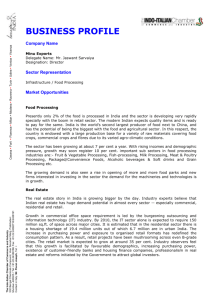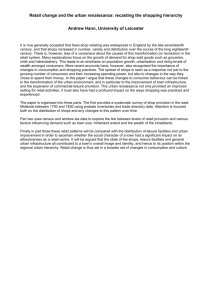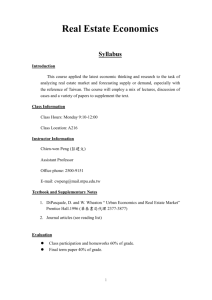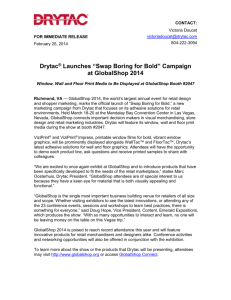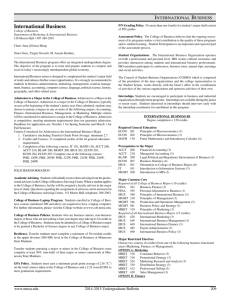property in perspective
advertisement
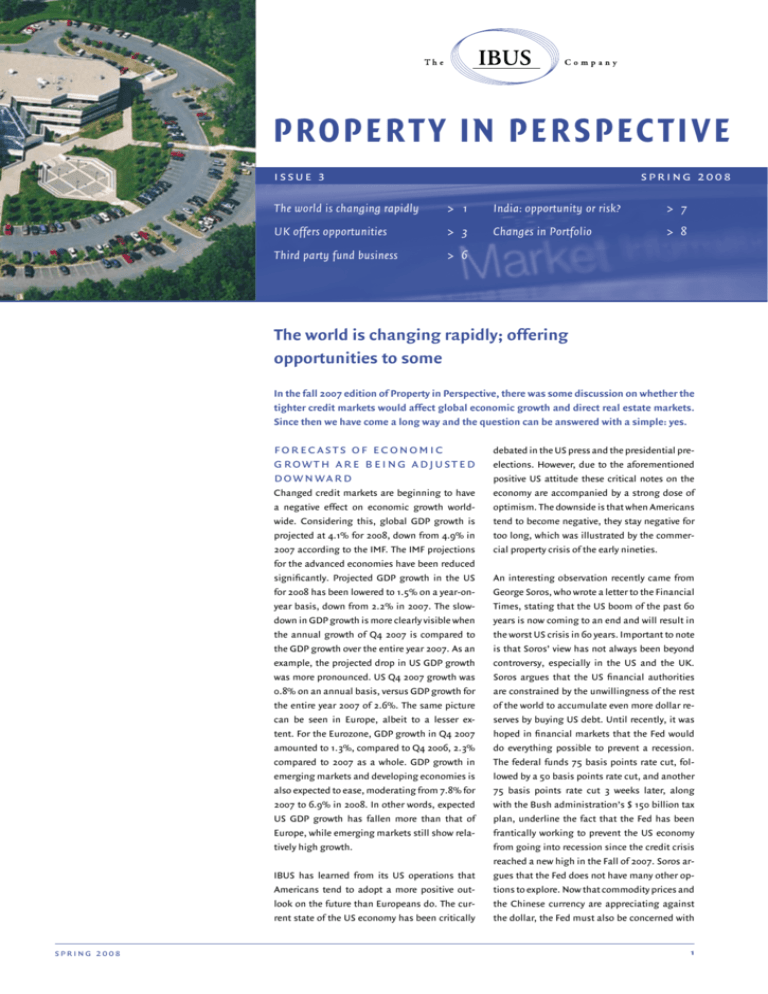
P ROPERTY IN PERSPECTIVE issue 3 spring 2008 The world is changing rapidly > 1 India: opportunity or risk? > 7 UK offers opportunities > 3 Changes in Portfolio > 8 Third party fund business > 6 The world is changing rapidly; offering opportunities to some In the fall 2007 edition of Property in Perspective, there was some discussion on whether the tighter credit markets would affect global economic growth and direct real estate markets. Since then we have come a long way and the question can be answered with a simple: yes. forecas t s o f e c o n o m i c growth a r e b e i n g a d j u s t e d downwa r d Changed credit markets are beginning to have a negative effect on economic growth worldwide. Considering this, global GDP growth is projected at 4.1% for 2008, down from 4.9% in 2007 according to the IMF. The IMF projections for the advanced economies have been reduced significantly. Projected GDP growth in the US for 2008 has been lowered to 1.5% on a year-onyear basis, down from 2.2% in 2007. The slowdown in GDP growth is more clearly visible when the annual growth of Q4 2007 is compared to the GDP growth over the entire year 2007. As an example, the projected drop in US GDP growth An interesting observation recently came from George Soros, who wrote a letter to the Financial Times, stating that the US boom of the past 60 years is now coming to an end and will result in the worst US crisis in 60 years. Important to note is that Soros’ view has not always been beyond controversy, especially in the US and the UK. was more pronounced. US Q4 2007 growth was 0.8% on an annual basis, versus GDP growth for the entire year 2007 of 2.6%. The same picture can be seen in Europe, albeit to a lesser extent. For the Eurozone, GDP growth in Q4 2007 amounted to 1.3%, compared to Q4 2006, 2.3% compared to 2007 as a whole. GDP growth in emerging markets and developing economies is also expected to ease, moderating from 7.8% for 2007 to 6.9% in 2008. In other words, expected US GDP growth has fallen more than that of Europe, while emerging markets still show rela- Soros argues that the US financial authorities are constrained by the unwillingness of the rest of the world to accumulate even more dollar reserves by buying US debt. Until recently, it was hoped in financial markets that the Fed would do everything possible to prevent a recession. The federal funds 75 basis points rate cut, followed by a 50 basis points rate cut, and another 75 basis points rate cut 3 weeks later, along with the Bush administration’s $ 150 billion tax plan, underline the fact that the Fed has been frantically working to prevent the US economy tively high growth. from going into recession since the credit crisis reached a new high in the Fall of 2007. Soros argues that the Fed does not have many other options to explore. Now that commodity prices and the Chinese currency are appreciating against the dollar, the Fed must also be concerned with IBUS has learned from its US operations that Americans tend to adopt a more positive outlook on the future than Europeans do. The current state of the US economy has been critically spring 2008 debated in the US press and the presidential preelections. However, due to the aforementioned positive US attitude these critical notes on the economy are accompanied by a strong dose of optimism. The downside is that when Americans tend to become negative, they stay negative for too long, which was illustrated by the commercial property crisis of the early nineties. inflation. Moreover, the Fed will reach the level at which further rate cuts will lead to dollar depreciation and consequently selling-pressure in US bonds. This trend would lead to rising long-term interest rates in a macro-economic US economy, which needs lower interest rates. In other words, such a situation would paralyze the Fed in taking further action. In fact, such a deadlock situation for the Fed could turn out to be positive in the longer run as the two major underlying problems - the budget deficit on both the level of the central government as well as on the level of US consumers - should receive higher priority. For now, a US recession seems to have become more likely, but economic growth in China, India and a number of oil-producing countries will prove to be a strong counter-trend in global growth to the negative momentum for the US economy. We believe that the current market conditions provide opportunities to long-term oriented, conservative real estate investors, as pricing becomes more in-line with fundamentals again. Current market conditions offer best opportunities to parties that do not rely in their funding on securitization of their funding nor on Moody’s or S&P for their funding, as these two elements have contributed to a large extent to the ferocity of the credit crisis. us ho u s i n g m a r k e t s t a y s weak In August 2006, Barron’s magazine warned that “a housing crisis approaches”. In 2007 US homebuilders sliced housing starts by 38% on an annual basis, and housing starts have dropped by more than 50% since the highs of early 2005. The unsold inventory for US housing stock, expressed in the number of months of new supply, has risen to 9.6 months (previous peak was 9.4 months in the early nineties). In other words, the current stock of unsold houses approximately equals production for three quarters of a year. US home prices are now down 9% from their mid-2006 highs. As a comparison, in the period from 1989 - 1992 residential prices declined by 8%. Housing starts are now down to 1.0 million units per year, which is 1991 level. Existing home sales fell 2.2%, month-on-month to 4.89 million units at an annual rate in December 2007. This number represents a 23% decline on an annual basis. House ownership in the US has dropped from 69% at its peak in 2004 to its current level of 67.7%. We believe that the US housing market will create negative momentum for some time, having repercussions through the entire US economy. The major question at this moment is whether the housing problems and the inherent rise in bad housing loans will also impact on loans for other assets, like cars, other luxury goods and credit card debt. It is hard to imagine that the recent actions by the Fed and the Bush administration will be of any material impact to offset the underlying negative trend. c o m m e rc i a l r e a l e s t a t e markets are changing Although many property broker reports still indicate that commercial real estate markets will remain untouched by the current turmoil, it is becoming increasingly harder to back this theory in practice. An increasing numbers of Sellers will have had experience by now that a transaction was not completed because the Buyer was not able to fund or to execute the deal. This has led to a situation whereby the number of auctions or rounds of best bids has reduced dramatically and an increase of direct negotiations between a Seller and a targeted Buyer, which leads to a more balanced relationship between Buyer and Seller. The focus of the Seller is no longer on achieving the highest possible price but on making sure that the transaction is executed successfully at a decent price. In the current less liquid markets, Sellers are focusing on making sure that they succeed in selling assets. Name, reputation of the Buyer, speed of process and the need for the Buyer to use debt to finance the transaction are decisive points on which to chose a certain Buyer. These statements are true for most property markets. However, the differences between transparent markets like the UK and less transparent markets like Germany are substantial. As a result, the price correction in the UK is swift and steep but the correction takes less time, whereas the German market will keep moving in negative territory for a longer period of time with hardly any transactions actually being done. A recovery will also kick in quicker in a transparent market like the UK, whereby recovery kicks in as soon as confidence returns to the property in perspective Retail warehouse Wickes, Bracknell UK offers opportunities The credit crisis, which is currently affecting worldwide real estate markets, has hit the UK market. The effect of this is that the IPD UK index has been showing substantial declining capital values for UK real estate in the second half of 2007. In December 2007, the IPD UK total returns on a monthly basis (versus November 2007) were negative: negative total return of 15% in the period until December 2008, which underlines that the market is still experiencing a negative market sentiment at the moment. December 2007 versus November 2007 • All property -3.7% (whereby capital growth was -4.2%) • Retail -3.4% (whereby capital growth was -3.9%) • Office -4.7% (whereby capital growth was -5.1%) • Industrial -3.0% (whereby capital growth was -3.5%) In retrospect, the peak in the market was reached in mid 2007 just after IBUS sold its last UK investments. In comparison to the market peak in the summer of 2007 the following total returns have been recorded: IPD UK total returns in December 2007 versus 30/6/2007 (market peak): • All property -9.5% • Retail -10.2% • Office -9.3% • Industrial -8.2% It is important to note that all of these numbers are before gearing, which implies that a number of UK property funds have taken hits in their Net Asset Values of 20 – 50% since the peak in the summer of 2007. As an example, New Star’s UK Property Unit Trust reported an 8.2% fall in value for November 2007, no value adjustment in December 2007 and another fall by 0.5% in January 2008. This implies that the value of its assets is now down 17.8% since the end of July, all before gearing. New Star states that there is a lack of transactional evidence making valuations tough and now values twice per month. 64% of the portfolio is invested in offices, 24% in retail, and 12% in industrial. From July 2007, the Fund (which has a stock listing) showed a decline in value by some 48% (after gearing). Protego’s Property Index Certificates offer the opportunity to trade futures, which gives an indication of future market expectations of slides in real estate values. The UK PIC’s are now trading at levels for December 2008 showing a spring 2008 Financing has become more difficult. However, for borrowers with existing banking relationships, good track records, appropriate covenants and interest coverage on the assets, debt financing is still available. This has reduced the number of potential buyers dramatically; the only potential buyers in the current market tend to be big family trusts or opportunistically driven low leverage investors. The investment market for larger investment volumes has been hit in particular. According to CBRE net initial yields on prime high street real estate are back at levels where they were in Q1 2005. CBRE states that net initial yields in all sectors have risen by 50 bps in Q4 2007 versus Q3 2007. This is the strongest move in yields since 1990. For high street shops net initial yields based on market rents have shifted from an average of 4.6% (Q2 2007) to 4.9% (Q3 2007) and 5.4% in Q4 2007. Rental growth for high street shops is still healthy at 3.5% per annum. In the retail warehouse segment a similar pattern can be seen. Net initial yields have moved from around 4.0% by mid 2006 to the current net initial yields on around 6.0% for rack rented, good quality products with long lease contracts. The first buying opportunities have arisen in the retail warehouse segment. IBUS has successfully acquired two big box retail warehouses in an edge-of-town location at a net yield of 6%. These are assets that would have been sold less than 12 months ago for a net yield of around 4.5% – 4.75%. In general, vendors in the current market are UK institutional investors selling due to redemptions in funds for either private or institutional investors. In recent weeks a number of renowned institutional real estate managers like Norwich Union, New Star, Scottish Equitable (Aegon), Scottish Widows, Close Investments, AXA UK Property Fund, Protego UK Fund Graph 1 Net initial yields UK retail 10% 9% 8% 7% 6% 5% 4% 3% 2% 1% 0% 81 82 83 84 85 86 87 88 89 90 91 92 93 94 95 96 97 98 99 00 01 02 03 04 05 06 2007 Retail Parks Retail Warehouses High Street Shops Source: IPD, Picture with historic net yields on UK retail and Friends Provident have put a freeze on withdrawals by investors for a period ranging from 6 months to 1 year. This implies that investors can not withdraw from these funds in the meantime, thereby giving the fund managers time to sell assets or the market time to settle down. Data provided by the Association of Real Estate Funds (64 member funds; all UK property funds) showed redemptions totalling 3.83% of NAV (£ 1.65 billion) for Q4 2007. In Q4 2007 more than £ 400 million of new money was raised. However, net outflows dominated the sector in Q4 2007. Over £ 3.7 billion of new money was raised in 2007. This resulted in a net inflow of £ 200 million during the entire year 2007. A small number of investors consider the current state of the UK market as offering buying opportunities. Private equity group Evans Randall has acquired a London office building Condor House, which is its first asset for its £ 1 billion opportunity fund targeting UK commercial real estate discounted by property market stress. The price was £ 115 million reflecting a 5.3% net initial yield. Resolution successfully closed on its 3rd capital raising with € 800 million of new equity committed from ‘’leading European and US private equity investors’’. The Fund’s first acquisition, a 3-acre leisure complex in the center of Manchester has been acquired for around £ 100 million. The equity raised will give Resolution up to € 4 billion of spending power including gearing. Resolution plans to acquire retail, office, leisure, residential and other commercial property in targeted locations throughout the UK and continental Europe. UK listed property company Helical Bar has made cautious statements on the UK market but also stated that the current market offers “an opportunity […] to buy investment stock at appropriate yields for the first time since 2005’’. Australian listed company, Valad has raised $ 175 million of equity from 3 institutional investors (one from Europe, one from Australia, one from the Middle east). Valad will use the capital for a GBP 500 million opportunity fund targeting multi sector opportunities in the UK. Bank of Scotland Corporate is a cornerstone equity investor of this fund. The market correction, which is currently taking place, is spreading to high street shops and office property as well. Moreover, the number of high street shops being offered at interesting prices is still limited as individual units can be sold one by one to private investors as well, thereby achieving higher prices. However, such a process tends to take more time and effort to realize. For investors in need of the cash on short notice, it therefore still can be an option to sell high street shops as a portfolio. So far, price correction has not reached the high street investment market for individual shops eg. the private investors market, whereby this market might follow in due course as well. current state of the uk economy and retail market The UK has a total population of 60.6 million inhabitants. As a result of immigration, the UK is one of Europe’s only countries with a growing population. Growth of the British population has even accelerated in recent years. Growth per annum was 0.4% in the period between 1991 and 2004 and has been +0.5% per annum since 2001. According to current market expectations the UK will have a total population of 70 million inhabitants in 2030. As a result of the worldwide decreasing economic growth, growth expectations including UK growth expectations have been adjusted downward in recent property in perspective Retail warehouse B&Q, Aylesbury weeks. However, expectations are that this will not result in a UK recession, partly due to the fact that the Bank of England (BoE) is expected to aid the economy with lower interest rates if needed. GDP growth rates by the BoE have been adjusted downward from 2.8% in 2008 to 2.5%. However, consensus GDP estimates are lower than these ‘official’ levels at 2.0% for 2008 and 2.4% for 2009. Markets expect the BoE to lower the official interest rates from 5.75% by 3 steps of 25 bps to 5.0% in 2008, whereby the main considerations are that GDP growth is at the lower end of expectations and inflationary pressure is currently limited. The BoE recently lowered its rate by 25 basis points. UK retail sales developed positively until the end of 2007. Quarter-on-Quarter growth has settled at a lower but still positive level than 12 months ago. In Q4 2007, UK retail sales rose by 0.4% on a QoQ basis (whereby the growth rate was 1.0% in the period from Sept – Oct 2007 which implies that the growth rate is declining). annum. This makes the UK one of IBUS’ most successful markets. In Q4 2007, the food sector grew by 0.3% on a QoQ basis, whereas non-food showed 0% growth in the same period. Lowest growth in Q4 2007 was recorded by non-specialised stores (including department stores) with a decline in turnover by 1.6% on a QoQ basis. In 2002 and 2003 IBUS entered the UK retail market and more specifically the high street retail market with two specific high street retail funds. The assets in these were funds were located on the prime pitch of 19 medium sized UK cities like York, Norwich, Brighton, Wrexham, Windsor and Kingston-upon-Hull whereby the assets could be described as core. The loan-tovalue level of the first fund was 58% whereas the second investment was an all equity investment. These investments were exited in 2006 and 2007 in single asset sales achieving solid annual IRR’s after fees of 19.0% and 9.8% for the all equity fund. If Q4 2007 is compared to Q4 2006, UK retail sales are 3.6% higher. Turnover of non-food retail grew in Q4 2007 by 4.4% versus Q4 2006. Turnover in Q4 2007 in clothing, textile and shoes was 1.9% higher than in Q4 2006, making this the lowest growth since 1999. Turnover of food stores increased in Q4 2007 by 0.9% in comparison to Q4 2006. All in all, although current UK retail sales growth is lower than it has been in recent years, the current growth numbers are still healthy. t r a ck-record and history o f i bus in the uk The UK real estate market is one of IBUS’ core markets. IBUS has been active as an investor in the UK from 1997 until 2007. IBUS has had investments in the UK office, residential and high street retail market with a combined investment volume of around £ 140 million and an average realized IRR after deduction of fees of 16.0% per spring 2008 IBUS entered the UK office market in 1998 with two dedicated office funds, one with assets in Isleworth and Cardiff and one with assets in Putney and Fareham. These assets were sold in 2002 and 2003. Realized IRR’s per annum after deduction of fees of these funds have been 20.3% and 13.3% respectively whereby the office properties could be described as core+ assets, whereas the loan-to-value levels amounted to 55%. In 1999, IBUS entered the UK residential market with the acquisition of a £ 20 million residential portfolio of repossessed properties and a portfolio from a bankrupt building society. This fund followed a rationalisation strategy, the assets core+ to value add and realized an IRR per annum after fees of 17.6%. The last units were sold in 2004. The assets had a loan-to-value ratio of a little over 50%. As a result, IBUS has vast in-house experience in the UK market, both on the real estate as well as on the legal, fiscal and deal sourcing side. When the last assets were sold in 2007, IBUS intended to return to the UK once market conditions offered opportunities again. IBUS is well positioned to benefit from these market changes as a result of its network being in place, therefore having the opportunity to quickly react to market opportunities. IBUS has recently become active in the UK retail market again and is expanding its UK retail exposure. Third party fund business IBUS has historically offered its HNW and private clients a variety of US direct investment products which it self-manages. Over the last few years, IBUS has been working closely with New York-based manager Sentinel Real Estate to offer institutional real estate products to Dutch and European pension funds. To date, the Sentinel funds have raised in excess of $ 250 million of equity in the Netherlands through IBUS for core and value-added strategies in the US residential sector. Sentinel launched its first Dutch offering, the Sentinel US Property Fund, Inc (“SUSPFI’), in 2004. The fund invests in Class A, well-located multi-family communities throughout the US. This fund has received investments from five Dutch institutional investors totalling approximately $ 110 million. The total assets of the fund are approximately $ 400 million with the balance coming from US institutions. In 2007, Sentinel launched another fund with the help of IBUS. This fund invests in New York City residential properties. The fund targets investments in rapidly gentrifying neighbourhoods where improving the physical asset will have a substantial benefit on rents. A total of five Dutch institutions are participating in this fund for a combined equity commitment of $ 155 million, whereas the total equity commitment is $ 235 million. Sentinel, established in 1969, is a privatelyowned real estate firm investing on behalf of global institutional investors. The firm manages a series of funds which contain investments in the US multi-family, industrial, office and retail sectors. Sentinel has approximately $ 5 billion of assets under management and currently manages approximately 45,000 apartment units and 9 million square feet of commercial space. Sentinel provides its clients a full range of investment advisory and property management services. In total, the firm has approximately 1,500 employees. In September 2007, Sentinel acquired listed REIT America First Apartment Investors. America First was a multifamily real This announcement appears as a matter of record only. October 2007 Sentinel Real Estate Corporation is pleased to announce the second closing of $235,000,000 GOTHAM CITY RESIDENTIAL PARTNERS I, LP Investing in the New York City apartment market. The IBUS Company is acting as exclusive placement agent in The Netherlands, and Rum Hill Capital LLC in Germany and Austria. To learn more about Gotham City Residential Partners I, please contact: David Weiner +1 212 408 2913 weinerd@sentinelcorp.com Michael Streicker +1 212 408 5023 mstreick@sentinelcorp.com www.sentinelcorp.com In its advisory role, IBUS assists in the structuring, marketing, and placement of each of the Sentinel funds within the Dutch institutional community. The benefit to IBUS of combining dedicated institutional money for IBUS funds with third party placement of institutional funds is the ongoing interaction with the institutional investors. It is also interesting to note that investor appetite between institutions and HNW clients often differs. Moreover, market knowledge within the IBUS organization improves with links to both private investors as well as institutions. IBUS will actively expand on this knowledge by looking at new possible third party institutional fund partners in Europe and Asia. estate investment trust. The transaction was valued at approximately $532 million, including the assumption of outstanding debt and excluding transaction costs. property in perspective Taj Mahal, India. India: opportunity or risk? Over the past six months a large number of both listed and non-listed property companies focusing on real estate investments in India have been coming to the market, all looking to attract investor capital for their first Asian investments. After almost five years of unprecedented economic expansion, the latest economic indicators reveal that the Indian economy is set to slow to a more sustainable rate. The gloomy outlook for the US economy will have a negative impact on the Indian economy, but the slowdown in India is expected to be shallow, with real GDP growth decelerating to 7.5% in 2008/09 and 7.2% in for such partner to be able to execute in a rapidly changing market with bureaucratic and legal obstacles and un unprofessional planning environment. The final crucial element of importance in the development partner is his organizational skills; as it will prove challenging to realize a project in a market where labor and construction costs are rising, thereby obviously 2009/10. That makes India an interesting investment target. India is the second most populous country in the world, with nearly 1.1bn people in 2006. The Indian economy is the twelfth largest in the world measured in nominal US dollars, but rises to the fifth largest when measured at purchasing power parity exchange rates. The large (and inefficient) public sector co-exists with a sizeable and diversified private sector. India gained independence in 1947, after two centuries of British colonial rule. There is a great number of upcoming cities in India: Agra, Amritsar, Bhiwadi, Bhopal, Bhubaneshwar, Coimbatore, Greater Noida, Greater Bangalore, Goa, Ghaziabad, Indore, Jaipur, Jalandhar, Jamshedpur, Jammu, Kochi, Kanpur, Ludhiana, Mangalore, Mysore, Manesar, Mohali, Nagpur, Nashik, Neemrana, Panipat, Rudrapur, Sonepat, Srinagar, Thiruvananthapuram, Visakhapatnam and Zirakpur. As all of these cities and regions are experiencing both high economic as well as demographic growth, the real estate market in India can be described as highly interesting. However, in order to be able to transform the opportunities into actual profit to the investor a number of crucial requirements should be met. affecting the investment cost of the project to a large extent. •Family ties It all depends on the right partners in the project and more particularly on the right family links. Per city a number of wealthy families determine who handles which project. Without the right family links, capital will not be able to be put to work properly. •Land ownership Land owners typically do not sell in India but remain stakeholder in a development project because land ownership is the key to success for a project. This implies that a substantial part of the development margin ends with the land owner. This implies that the development margin might be smaller than initially expected. •Zoning Zoning for a project typically takes one year or longer. India is known to be bureaucratic, which means it is important to distinguish between the projects which have received zoning, and the ones still waiting to receive zoning. • Development partner(s) The quality of existing real estate product in India is limited. Therefore the focus tends to be on the development of new residential, office, retail, hotel space or whole newly developed •Lock-ups India has 3 year lock-ups for foreign investors; not allowing any capital to be withdrawn from the country in the first 3 years. Investors therefore need to have a long-term view. urbanizations containing all of the above. The success of a Fund depends entirely on the development capabilities of the local development partners. This is not just the reliability of the partner but even more important the trackrecord of the development partner. It is crucial In general this means that, while demographic and economic trends support the growth and performance of the Indian real estate market, it is wise to be carefull when considering the investment opportunities being offered. spring 2008 CHANGES I N P O RT F O L I O During the last six months the following changes took place in the IBUS Real Estate Portfolio Germany Acquisition of high street retail portfolio Portfolio of 21 high street retail properties in medium to smaller sized cities in northern and eastern Germany. The total acquisition price (including costs) is € 33.0 million. The portfolio has a GLA of 21,582 sqm plus 13 car parks. Germany Acquisition of a mixed residential and retail portfolio This Portfolio consists of 173 residential units (8,544 sqm) and 20 retail properties (2,002 sqm). The properties are located in the Goslar region and in Oldenburg. The total acquisition price (including costs) is € 10.2 million. United Kingdom Acquisition of a retail warehouse This retail warehouse, let to Wickes, is located in Bracknell in the greater London area. The building has a GLA of 40,205 sq ft and 163 parking places. The acquisition price of the building (including acquisition costs) amounted to £ 15.07 million. Acquisition of a retail warehouse This retail warehouse has a GLA of 38,997 sq ft and 233 parking places. The building is let to B&Q and is located in Aylesbury in the greater London area. The acquisition price of the building (including acquisition costs) amounted to £ 11.1 million. Lincoln building, Boston, MA, United States Krijgsman 6 P.O. Box 8010 1180 LA Amstelveen T. +31 (0)20-755 90 00 F. +31 (0)20-755 90 90 E-mail: info@ibus.nl www.ibus.nl Acquisition of a high street retail portfolio This portfolio consists of 5 high street retail properties on prime locations in Cambridge, Ipswich, Southend, Dorchester and Maidstone. The total GLA of the portfolio is 13,234 sq ft. The acquisition price (including acquisition costs) amounted to £ 16.39 million. The properties mentioned above are, or have been part of investment funds for private individuals or institutional investors. The IBUS Company is an independent group established in 1992 by Onno Husken, former Chief Executive Officer of Wereldhave N.V. and Kempen & Co. IBUS develops and invests in office, retail, residential and hotel properties in the United States, Europe and Asia. Since inception, 44 real estate funds, with a total investment consideration in excess of € 1.2 billion, have been introduced with private and institutional investors. Over the years, more than half of these investments were successfully sold. IBUS also uses its real estate knowledge and experience to advise financial institutions, listed companies and institutional investors. These assignments are directed towards portfolio analysis, asset allocation policy, investment strategy and second opinions on direct and indirect real estate investments. A team of over 50 professionals is based in offices in Amstelveen (The Netherlands), Washington DC (United States) and Ho Chi Minh City (Vietnam). 8 property in perspective
